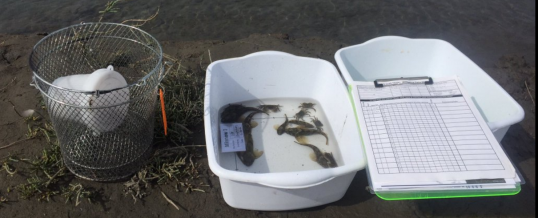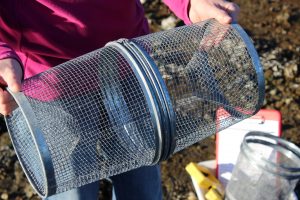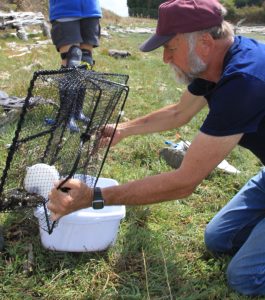
One strength of the Crab Team protocol is that it enables us to confidently compare findings among different sites, and track changes over time – even if different people are doing the sampling. With sampling on this scale, even the small steps can be important to what we learn from the data. The Protocol in Focus will allow us to expand on these details, and offer an opportunity to see all the behind-the-scenes planning that goes into methodology!
Some volunteers have noticed that the Fukui traps are more often empty, or have lower trap catches, than the minnow traps. This raises a reasonable question: Why don’t we just use 6 minnow traps? That way would catch more critters and therefore get a better idea of what is living at the site. Fair question, particularly given the fact that Fukui traps are about eight times as expensive as minnow traps, and have to be imported from Japan. It can also be more challenging to get the particularly tenacious shore crabs and tangled staghorn sculpin out of the netting in the corners of the Fukui trap and into the sorting bins.

On critters small enough to fit through the hole can get in the minnow trap. Photo: J. Adams
The answer is that we use two types of traps because that allows us to target different sizes and shapes of critter. The hole into our minnow traps measures about 1 inch (25 mm) in diameter and the mesh is 1/4″ (6mm) at the widest. This means that these traps will catch crabs, fish, and shrimp between those sizes. Anything bigger – at the smallest dimension – won’t be able to get in, and anything smaller can crawl out. The Fukui traps have much bigger openings, and the mesh is 1/2″ (12 mm). In the unmodified trap, the opening is as wide as the trap (16″ or 0.4 m), and can stretch several inches tall, so much bigger critters can get in. In fact we have purposely reduced the opening width by half, by zip-tying the mesh together in the middle of the slot. Crab Team member Sean McDonald has used Fukui traps for a long time in his research. In some spots where he has sampled, he has found that leopard sharks were attracted to the yummy bait. And they are so large, that they fill up the trap and make it hard to even open the trap to get the fish out. That’s extremely unlikely at any of our sites, but we do want to avoid catching any terrestrial animals that might be interested in trying to get at the bait, such as raccoons, cats, or opossums. We time our surveys so the traps are always in the water, reducing that possibility, but making the trap opening smaller is another way we try to keep those unwanted data points out of the traps.
Fukui traps, therefore, capture much larger critters, and would be the only traps that adult green crabs would be able to fit into. There are also some species that can only fit into Fukui traps based on the shape of the opening, like starry flounder. Using both types of trap, therefore, gives us the best snapshot of what species are living at the site, and what their overall size is.

It can involve a bit of dexterity to get critters from a Fukui trap into the bin. Photo: D. Paros
Ok, so, wouldn’t the perfect trap have a large opening, to allow lots of things in, but small mesh to make sure that as much as possible is retained in the trap?
Another good thought. One reason that it is good to keep the big crabs and fish apart from the small crabs and fish is that the rule of the pocket estuary kingdom is: big things eat little things. Because they concentrate the animals in a very confined space, traps can be a stressful and dangerous place for a small crab. While we do want to learn as much as possible about everything living in these pocket estuaries, we also want to minimize our impact on their populations.
Zeroes are also very important to our sampling scheme. Even if the Fukui traps always come up empty we learn something about the site: that there are no large crabs that visit that area. If we only set minnow traps, we wouldn’t know whether or not large crabs were present, because we wouldn’t have even been able to catch them. Our systematic use of traps enables us to be confident that when we don’t find large crabs, or adult green crabs, it’s because they aren’t present at the site. And remember that the community of organisms at a site can change over time, just because we don’t find them one month or one year, doesn’t mean they won’t be there the next.
Lastly, Fukui traps are the industry standard for green crab trapping. Because green crabs are “shore crabs”*, we set traps from the shore, rather than a boat. So light, portable, salt water-resistant traps are key to this work. Using Fukui traps means that we can compare our numbers to other researchers working on green crabs worldwide.
* “Shore crabs” is a general term that tells us that they live at relatively shallow, intertidal elevations, compared to many of our large crabs, which live in deeper waters as adults. We call our two native species of Hemigrapsus shore crabs because they also live at relatively high elevations for a crab.
Thanks for all the great questions and ideas. Please keep them coming, it helps us strengthen our monitoring and training to have your feedback and questions. Check out our FAQ in the Volunteer Toolbox on the Crab Team website for more protocol questions.
–June 7, 2016
Return to News page.
Return to Crab Team home page.
Follow @WAGreenCrab
JUN
2016